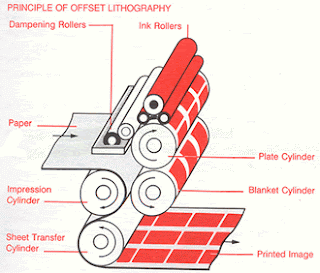- Etched alluminium plates are wrapped around a cylinder. The image is transferred or 'offset' from one cylinder to another.
- Medium must be flexible as has to go through roller.
- Was invented in 1796 by Alois Senefelder as a low-cost method of publishing theatrical works.
- A basic principle of litho is that oil and water do not mix.
Principle of offset lithography
- More refined images because of a use of copper plates.
- Expensive but more durable - can do huge runs.
- denser ink coverage, can be used for floor coverings and also large magazine print runs.
I believe money is printed using the gravure process as there is a massive print run and impressive detail. This should also be printed in specially mixed colours to prevent replication. The stock would also be special paper and format. There are special finishes added to money such as embossing, metalic threading and UV inks. All of these specials and the high quality is needed otherwise they would be replicated.
Flexography (Flexo)
- Polymer plate used.
- Registration is not as good as when using other methods of rotary printing (litho and gravure).
- Different stocks can be used such as cellophane and plastics.
Principle of flexo
This Ribena bottle is printed using Flexo. Printed onto plastic and then shrinked around bottle. Special spot colours have been used instead of CMYK, I could see purple, green, yellow, red, cyan and black. The stock is think plastic sheets which are easy to roll and shape. The plastic is perforated for an offer and this is a special finish applied to some prints. Due to the bright colours (achieved by special spot colours) this product is aimed at fun people. The competition is quite strong in this market and so the all over bright colours help this to stand out.






No comments:
Post a Comment